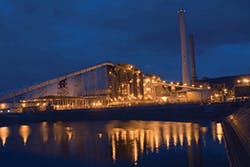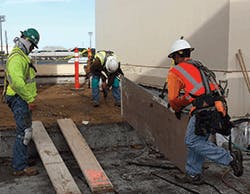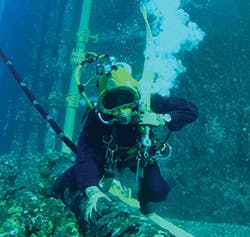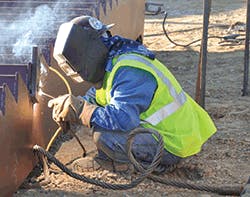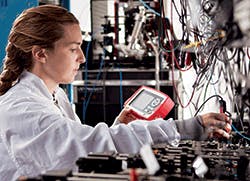America's Safest Companies Winners: The AES Corporation, Alan Shintani Inc., Aqueos Corporation, BL Harbert International LLC, The Charles Stark Draper Laboratory Inc., and dressbarn
The AES Corporation
Of the AES Corp.'s five core values, safety comes first.
"The first consideration in all our business and operational discussions is the impact on occupational safety and health that could result from the actions under consideration," explains Laszlo Hary, EHS director for the global electricity provider.
Six principles guide the company's safety efforts, starting with the expectation that local business leaders are accountable for EHS performance. Among the strategies that keep business and operational leaders engaged in safety and health "on a 24/7 basis," leaders annually conduct 115,000 safety walks in which they observe behaviors and engage with AES employees and contractors. The company has exceeded its monthly goals for the number of safety walks by 33 percent over the past year.
The AES Corp. Arlington, Va. — 17,800 employees and 32,000 contractors in 20 countries/200 EHS professionals
At AES, working safely and adhering to safety standards are conditions of employment. All AES employees and contractors are empowered – and obligated – to stop work if they identify unsafe conditions. Participation in monthly safety meetings is mandatory, and the company actively encourages employees and contractors to report safety concerns – confidentially – through the "Speaking Safety" system. As the company has operations in 20 countries, the Speaking Safety system's online and telephone reporting is customized for local languages.
Alan Shintani Inc.
"Without the full support of management, it's impossible to have a successful safety and health program," says Robin Ho, safety and health manager for general contractor Alan Shintani Inc.
Still, it's one thing for senior leaders to pay lip service to safety and health, and quite another for them to put their words into action. At Alan Shintani Inc., senior leaders walk the talk by helping project teams develop site-specific safety plans and job-hazard analyses for each project. They also visit job sites and conduct safety audits with workers.
Alan Shintani Inc. —
Waipahu, Hawaii 70 employees/10 safety-trained supervisors, 2 construction health and safety technicians
Management understands that a vibrant safety culture "saves both lives and money and plays a major role in the success of our business," and the company's commitment to safety and health has given the construction firm an edge in the bidding process. Tied with two other firms as the lowest bidders on a renovation project in Pearl Harbor, Alan Shintani Inc. won the contract because of its EHS performance.
"By having these elements in place, it takes away the need for our workers to ‘guess' on how to perform the work safely," Ho says.
Aqueos Corporation
There's not a lot of room for error in a commercial diving operation. Aqueos Corp., a privately held, commercial diving company, was established in 2000 with the premise that all incidents are preventable and a strong culture of safety has been evident since its inception.
Glass says that the company's HSE Management System leverages elements of compliance-based, behavior-based and people-based accident prevention models. For example, employees are encouraged to submit peer observations regarding hazards, near misses, at-risk and safe behaviors. Supported by the Aqueos HUB, which is a self-executing database program, significant submissions are shared real-time across all active jobs. Safety meetings occur before each shift with a format that follows the job-safety analysis for site-specific activities and operations. Safety observation submissions routinely are reviewed during these meetings.
Aqueos Corporation Commerical Diving and ROV Services —
Broussard, La., and Carpenteria, Calif. 200 employees/2 EHS professionals
"Several trends recently were discovered related to open dive knives during egress, open-ended air hoses connected to a charged system and bail-out bottles improperly stowed," says Glass. "Unabated, these conditions would eventually result in an incident. The Aqueos HUB communicated these trends enterprise-wide … This information resulted in improved operational discipline and the prevention of an incident."
Glass says that stop-work authority "is considered a responsibility at Aqueos," adding, "Hazard identification is integrated into the work style of personnel. The culture supports ownership of a solution if a hazard is identified."
BL Harbert International LLC
Safety starts at the top at general contractor BL Harbert International LLC, which provides construction, construction management and design-build services for a diverse range of clients. Billy Harbert, founder and CEO, addresses each new employee of BL Harbert, explaining that the company is committed to them returning home safely to their families at the end of the shift.
He says the company's approach to safety requires a constant "back to basics" evaluation: "What is working and what is not? Where can we do better? If something does work, then why?"
The company's philosophy of constantly challenging and questioning "makes our safety policy timely, relevant and ahead of the curve. We are not reactive to new regulations; rather, we often are proactive and have implemented a company policy long before OSHA mandates it," he adds.
BL Harbert International —
LLC Birmingham, Ala. 3,500 employees at 55 job sites around the world/58 EHS professionals; 1 at each job site and 3 at the corporate level
A few weeks ago, when summer temperatures were soaring, the company's corporate safety team distributed information about the dangers of drinking energy drinks and sports drinks instead of water during the day. They held a safety meeting on every job site and educated employees about the impact that heat and even mild dehydration can have when working during the summer, and the importance of staying properly hydrated.
"Reaching out in this informal way is so important, because true safety goes beyond a safety manual policy about having potable water available to workers. It is about being truly invested in their health, and [our] workers know it," says Wampol.
The Charles Stark Draper Laboratory Inc.
It makes no difference if you're a new employee or the CEO: To enter a hazardous area in one of the Charles Stark Draper Laboratory's facilities, you need the proper safety training – and your training must be up to date.
"The CEO and VP's take annual safety training to maintain their access to hazardous areas of interest to them," Najjar adds. "If anybody's training expires, the EHS office contacts the security office to take their access away until their training is current."
The Charles Stark Draper Laboratory Inc.—
Cambridge, Mass. 1,500 employees/7 sites/ 5 full-time EHS professionals
For Draper, a not-for-profit R&D lab that receives funding from the Department of Defense and other federal agencies, the ultimate goal of EHS is zero: not only zero injuries, but also zero risk of injuries. The R&D lab pursues that goal by emphasizing employee participation; leveraging metrics and leading indicators; developing comprehensive training and audit programs; reviewing contractors' EHS programs and procedures; and investigating all accidents, injuries, illnesses, spills and near-miss events, among other strategies. Draper also maintains wellness and ergonomics programs.
One important aspect of Draper's efforts to minimize risk is its approach to purchasing and monitoring hazardous chemicals. The EHS office approves the requisition of all hazardous materials and equipment before the purchasing department can place the order. The requisition of new hazardous materials triggers a job-hazard assessment that involves EHS staffers, line managers and workers.
Once approved and received, chemicals are logged into Draper's ERP system by the shipping and receiving department and delivered to the purchaser's work area. The system automatically notifies the purchaser to download the respective safety data sheet from the Draper SDS database.
"We know where all the hazardous materials are in our facilities," Najjar says.
dressbarn
While retail operations might not be seen as a hotbed of workplace hazards, the 8,000 sales associates at dressbarn's 845 stores know differently.
"As with many companies, accidents were just a part of doing business," explains Safety Manager Russell Del'Re of the company's former attitude toward safety. "Our new philosophy is centered around our motto of ‘Inspiring Women to Look and Feel Beautiful.' We recognize that our associates are our most important assets and we stand behind that. We recognize that even the smallest of accidents can be a less-than-inspiring experience."
Dressbarn Specialty Retail —
Headquarters: Mahwah, N.J. 400 corporate employees/8,000 associates in 845 stores; 3 EHS professionals
The age of associates ranges from late teens to early 70s and day-to-day activities are varied. "This creates a higher risk," says Del'Re, "so we try to tailor jobs for associates instead of tailoring associates for a job."
The company has launched several instructional videos over the past year, which were filmed by the company's production department and featured actual associates in dressbarn locations. The first video focused on the importance of reporting injuries and recognition of a near miss. The second was an instructional video on the best practices for ladder use. The most recent video focused on hazcom and the evolution of MSDS to SDS. The company currently is in production on a video about workplace violence.
In the meantime, Del'Re is working with company operations to ensure safer workplaces. The company recently introduced the Klever Kutter, a safety knife, and lighter ladders, because injuries and near misses were occurring when boxes were being opened or broken down and when ladders were being moved. "We also are testing an engineered device for the raising and lower of giant visual window posters from the ground" and are considering lowering wall displays, he says, which should eliminate the need for ladders in stores.
About the Author
EHS Today Staff
EHS Today's editorial staff includes:
Dave Blanchard, Editor-in-Chief: During his career Dave has led the editorial management of many of Endeavor Business Media's best-known brands, including IndustryWeek, EHS Today, Material Handling & Logistics, Logistics Today, Supply Chain Technology News, and Business Finance. In addition, he serves as senior content director of the annual Safety Leadership Conference. With over 30 years of B2B media experience, Dave literally wrote the book on supply chain management, Supply Chain Management Best Practices (John Wiley & Sons, 2021), which has been translated into several languages and is currently in its third edition. He is a frequent speaker and moderator at major trade shows and conferences, and has won numerous awards for writing and editing. He is a voting member of the jury of the Logistics Hall of Fame, and is a graduate of Northern Illinois University.
Adrienne Selko, Senior Editor: In addition to her roles with EHS Today and the Safety Leadership Conference, Adrienne is also a senior editor at IndustryWeek and has written about many topics, with her current focus on workforce development strategies. She is also a senior editor at Material Handling & Logistics. Previously she was in corporate communications at a medical manufacturing company as well as a large regional bank. She is the author of Do I Have to Wear Garlic Around My Neck?, which made the Cleveland Plain Dealer's best sellers list.
Nicole Stempak, Managing Editor: Nicole Stempak is managing editor of EHS Today and conference content manager of the Safety Leadership Conference.

